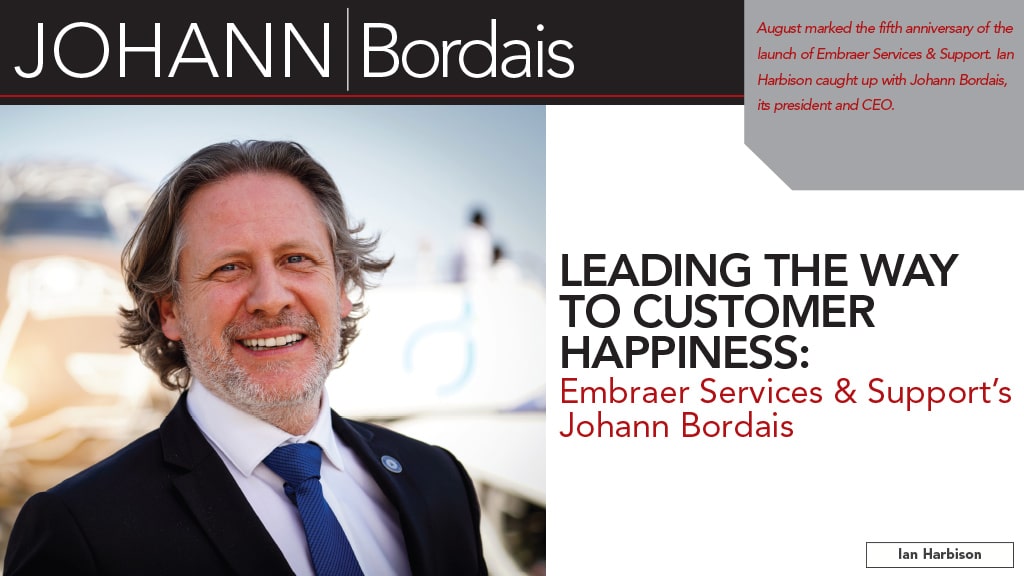Johann Bordais says it is all well and good to design, manufacture and deliver an aircraft but it is support for the customer afterwards that is the best way to establish a good reputation in the industry. He feels that Embraer Services & Support (ES&S) has achieved this, coming at the top of a number of independent aviation surveys. The company has manufactured more than 8,000 aircraft and still supports one very early EMB 110 Bandeirante, now some 45 years old.
Following the abortive deal with Boeing, ES&S has refocused and now works across all divisions of the company – Commercial and Executive Aviation, Defense & Security and Agricultural Aviation. That means good ideas from one sector can be quickly adopted and adapted by another to suit its customer base.
A good example of this intra-company cooperation is the Sorocaba Service Center, just over 100 miles west of the company’s main facility at São José dos Campos. This was established in 2014 and has been operated primarily for the Executive Jets division, providing maintenance, interior refurbishment, hangarage, airport services, stopover assistance and aircraft preservation. In addition, it has workshops for component overhaul and the capability to perform aircraft modifications, such as the conversion of Legacy 450 jets into Praetor 500 jets.
The Center recently doubled its capacity from 20,000 m² to 40,000 m² and now has four hangars, three of which are dedicated to MRO services and one to support fixed-base operator (FBO) operations. The extra space will not only cater for the expansion of business aviation in Brazil but can be used for commercial and defense aviation customers.
Another example is an MoU signed with Fokker Services and Fokker Techniek in October 2021, to explore opportunities in the defense, commercial and support markets. Bordais says there are similarities between Embraer and Fokker Services as both are well-known and reputable aerospace companies with roots in building aircraft and supporting aircraft fleets worldwide.
As a result, the MoU the companies announced, in July, the intention to deepen the collaboration in several projects, mainly related to the services and support fields. The companies are looking at aftermarket support topics, such as aircraft modifications and customization, program support, logistics, repair services. Looking further in the future, conversion and completion of Special Mission and Special Transportation aircraft in Defense, including collaboration for the C-390 multi-mission aircraft, whilst for the Commercial aviation market, engineering, repair, and logistics support will be key elements to be explored, in addition to Hydrogen Powered Aircraft development.
Previously, in May, Embraer announced a multi-year agreement for Fokker Services to provide MRO services covering 60-part numbers of engine line replaceable units (LRUs) enrolled in Embraer’s Pool Program. The Pool Program, which supports Embraer’s first-generation E-Jets aircraft, now covers 700 E170, E175, E190 and E195 aircraft flying with more than 50 airlines worldwide. The latest contract announced was with LOT Polish Airlines, which, at Farnborough, renewed and added seven E-Jets to the original contract, with the Pool now covering a total of 44 aircraft and over 300 components.
A major project for ES&S is the E-Jets Passenger to Freight (P2F) conversion, which was launched in March this year. This will be based on the E190 and the E195 and is intended to fill the gap between turboprops and narrowbodies while replacing less fuel-efficient regional jet freighters.
Bordais says the timing is perfect as the e-commerce market is still expanding and the aircraft’s field performance means it can utilise a range of smaller airports than larger narrowbody freighters, reducing delivery times. Feedstock is available as many earlier E-Jets that entered service around 10-15 years ago are now emerging from long term leases and being replaced. The conversion should extend their life by another 10-15 years. The company sees a requirement for 700 aircraft over the next 20 years and is aiming for a 20% market share.
The initial conversions will be carried out at São José dos Campos. This will include a main deck front cargo door; cargo handling system; floor reinforcement; 9G Rigid Cargo Barrier with access door; cargo smoke detection system, including Class E extinguishers in the upper cargo compartment; Air Management System changes (cooling, pressurization, etc); interior removal and provisions for hazardous material transportation. The company is currently evaluating the work package and looking at where the expertise of outside suppliers might offer advantages.
The first conversion should take seven to eight months and be completed and certified in 2024, but this should reduce to three months as production ramps up to five a year in 2025 and eventually to 10-12 per year. If there is sufficient demand, further conversion could be added, based on customer location.
The program kicked off in May with an agreement with Nordic Aviation Capital (NAC) for 10 conversions. At Farnborough, in July, NAC announced an MoU to place the first two E190F conversions with Astral Aviation, based in Nairobi, Kenya, while Embraer signed a firm order for a further 10 Embraer conversions with an undisclosed customer.
See related story on Embraer’s Beacon product next page.
